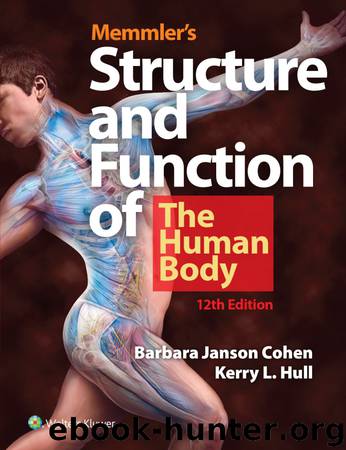Memmler's Structure and Function of the Human Body by Unknown

Author:Unknown
Language: eng
Format: epub
Publisher: Jones & Bartlett Learning, LLC
Published: 2019-10-03T22:00:00+00:00
BOX 14-1 Clinical Perspectives
Lipoproteins: What’s the Big DL?
Although cholesterol has received a lot of bad press in recent years, it is a necessary substance in the body. It is found in bile salts needed for digestion of fats, in hormones, and in the cell’s plasma membrane. However, high levels of cholesterol in the blood have been associated with atherosclerosis (hardening of the arteries) and heart disease.
It now appears that the total amount of blood cholesterol is not as important as the form in which it occurs. Cholesterol is transported in the blood in combination with other lipids and with protein, forming compounds called lipoproteins. These compounds are distinguished by their relative density. High-density lipoprotein (HDL) is composed of a high proportion of protein and relatively little cholesterol. HDLs remove cholesterol from the tissues, including the arterial walls, and carry it back to the liver for reuse or disposal. In contrast, low-density lipoprotein (LDL) contains less protein and a higher proportion of cholesterol. LDLs carry cholesterol from the liver to the tissues, making it available for membrane or hormone synthesis. However, excess LDLs can deposit cholesterol along the lining of arterial walls. Thus, high levels of HDLs (60 mg/dL and above) indicate efficient removal of arterial plaques, whereas high levels of LDLs (130 mg/dL and above) suggest that arteries will become clogged.
Diet is an important factor in regulating lipoprotein levels. Saturated fatty acids (found primarily in animal fats) raise LDL levels, while unsaturated fatty acids (found in most vegetable oils) lower LDL levels and stimulate cholesterol excretion. Thus, a diet lower in saturated fat and higher in unsaturated fat may reduce the risk of atherosclerosis and heart disease. Other factors that affect lipoprotein levels include cigarette smoking, caffeine, and stress, which raise LDL levels, and exercise, which lowers LDL levels.
Download
This site does not store any files on its server. We only index and link to content provided by other sites. Please contact the content providers to delete copyright contents if any and email us, we'll remove relevant links or contents immediately.
| Administration & Medicine Economics | Allied Health Professions |
| Basic Sciences | Dentistry |
| History | Medical Informatics |
| Medicine | Nursing |
| Pharmacology | Psychology |
| Research | Veterinary Medicine |
Dynamic Alignment Through Imagery by Eric Franklin(3913)
Body Love by Kelly LeVeque(2904)
Barron's AP Calculus by David Bock(1717)
EMT Exam For Dummies with Online Practice by Arthur Hsieh(1613)
The Juice Lady's Remedies for Asthma and Allergies by Cherie Calbom(1519)
Fitness Walking For Dummies by Liz Neporent(1464)
Extremes: Life, Death and the Limits of the Human Body by Fong Kevin(1416)
Flight by Elephant(1411)
McGraw-Hill Nurses Drug Handbook by Patricia Schull(1395)
The Natural First Aid Handbook by Brigitte Mars(1327)
Tell by Major Margaret Witt(1311)
Skin by Unknown(1289)
Seeing Voices by Oliver Sacks(1279)
Born to Walk by James Earls(1242)
Cracking the Nursing Interview by Jim Keogh(1213)
First Aid for Colleges and Universities (10th Edition) by Mistovich Joseph J. & Limmer Daniel J. & Karren Keith J. & Hafen Brent Q(1190)
The Yoga Bible by Christina Brown(1189)
The Advantage by Lencioni Patrick M(1099)
Living Ready Pocket Manual - First Aid: Fundamentals for Survival by James Hubbard(1096)
